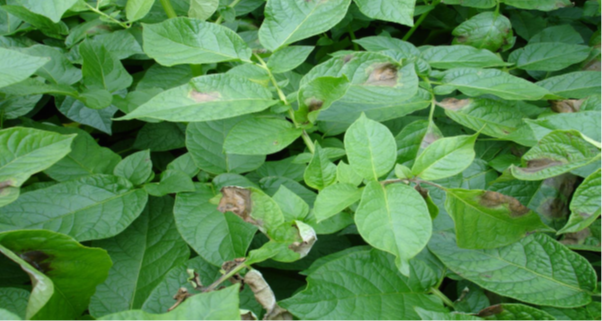Blight Risk Update – Sept 2019
8 September 2019Blight risk update
Unsurprisingly, there has been a surge in the number of late blight outbreaks across Scotland. So far the Fight against Blight service has 80 reports of outbreaks in Scotland, this is a larger figure than the end of season totals for recent years.
When it comes to the blight genotype (strain), although the 6_A1 strain is still the most frequent one found, several outbreaks have been classified as 36_A2 and at least one as 37_A2 (a strain less sensitive to fluazinam).
A blight spray programme does not end when desiccation starts – as long as there is living plant tissue, the pathogen can infect it. Watch out for re-growth of plant tissue if desiccation has not been effective if this becomes blighted it can act as a source of spores.
Given the high risk and pressure this season, product choice is particularly important. Pick fungicides that have good activity against tuber blight, that offer some curative activity, and (particularly if blight has been active in the crop) that have anti-sporulant activity. Rainfastness is also important, especially if the difficult weather continues.
Tuber blight control
Some recent rainfall events inevitably lead to consideration of the risk of tuber infection. The main risk factors for tuber infection in the growing crop are the presence of foliar blight, together with high-risk weather to encourage sporulation, lower temperatures to favour the production of a high number of zoospores, combined with wet soil and substantial rainfall. Note that foliar blight does not need to be severe if the other factors are favourable.
Fluazinam-based products should not be used for tuber blight control because of the risk of selecting for less sensitive blight (i.e. genotype 37_A2) thus creating a high risk of inadequate future control of foliar and tuber blight. Alternatives to fluazinam are listed below.
Alternatives to fluazinam
| Product (Dose rate, litre or kg/ha) | Tuber blight rating (from EuroBlight trials)* |
|---|---|
| mancozeb (2.0) | |
| amisulbrom (0.5) + mancozeb (2.0) | 3.7 |
| cyazofamid (0.5) | 3.8 |
| propamocarb-HCl + fluopicolide (1.6) | 3.9 |
| propamocarb + cymoxanil (2.0) + cyazofamid (0.5) | 4.6 |
*Zero to five scale (0 = no effect, 5 = perfect control)
Sign up to the FAS newsletter
Receive updates on news, events and publications from Scotland’s Farm Advisory Service

